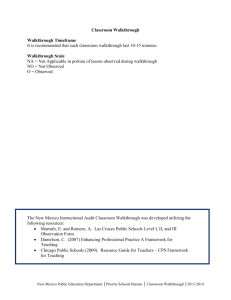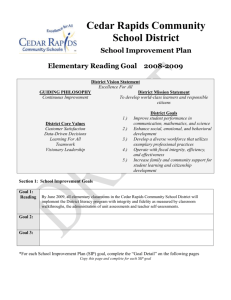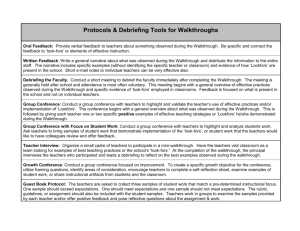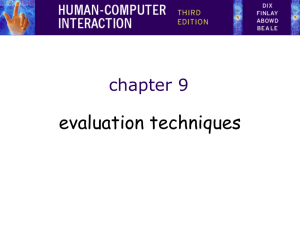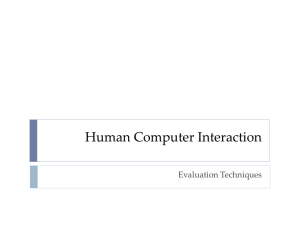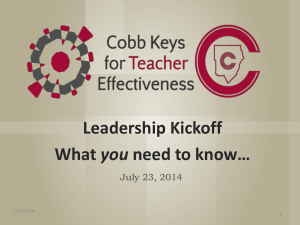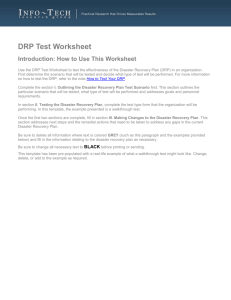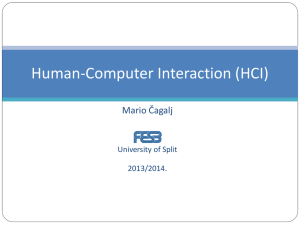Sheltered Instruction Walkthrough Rubric
advertisement
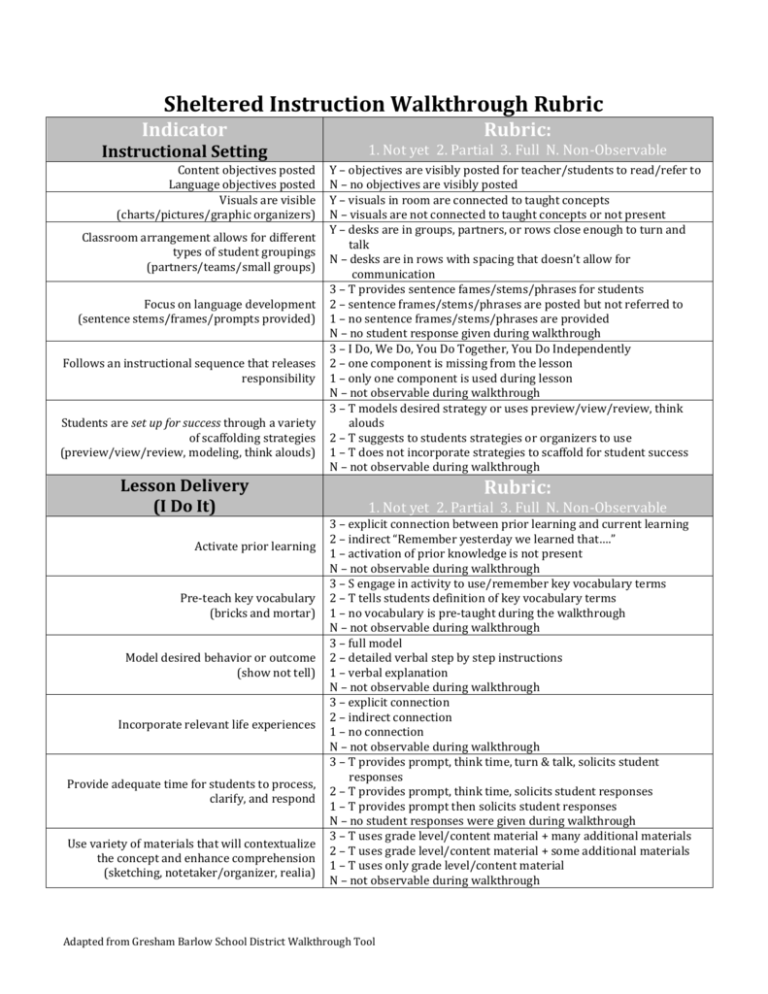
Sheltered Instruction Walkthrough Rubric Indicator Instructional Setting Content objectives posted Language objectives posted Visuals are visible (charts/pictures/graphic organizers) Classroom arrangement allows for different types of student groupings (partners/teams/small groups) Focus on language development (sentence stems/frames/prompts provided) Follows an instructional sequence that releases responsibility Students are set up for success through a variety of scaffolding strategies (preview/view/review, modeling, think alouds) Lesson Delivery (I Do It) Activate prior learning Pre-teach key vocabulary (bricks and mortar) Model desired behavior or outcome (show not tell) Incorporate relevant life experiences Provide adequate time for students to process, clarify, and respond Use variety of materials that will contextualize the concept and enhance comprehension (sketching, notetaker/organizer, realia) Rubric: 1. Not yet 2. Partial 3. Full N. Non-Observable Y – objectives are visibly posted for teacher/students to read/refer to N – no objectives are visibly posted Y – visuals in room are connected to taught concepts N – visuals are not connected to taught concepts or not present Y – desks are in groups, partners, or rows close enough to turn and talk N – desks are in rows with spacing that doesn’t allow for communication 3 – T provides sentence fames/stems/phrases for students 2 – sentence frames/stems/phrases are posted but not referred to 1 – no sentence frames/stems/phrases are provided N – no student response given during walkthrough 3 – I Do, We Do, You Do Together, You Do Independently 2 – one component is missing from the lesson 1 – only one component is used during lesson N – not observable during walkthrough 3 – T models desired strategy or uses preview/view/review, think alouds 2 – T suggests to students strategies or organizers to use 1 – T does not incorporate strategies to scaffold for student success N – not observable during walkthrough Rubric: 1. Not yet 2. Partial 3. Full N. Non-Observable 3 – explicit connection between prior learning and current learning 2 – indirect “Remember yesterday we learned that….” 1 – activation of prior knowledge is not present N – not observable during walkthrough 3 – S engage in activity to use/remember key vocabulary terms 2 – T tells students definition of key vocabulary terms 1 – no vocabulary is pre-taught during the walkthrough N – not observable during walkthrough 3 – full model 2 – detailed verbal step by step instructions 1 – verbal explanation N – not observable during walkthrough 3 – explicit connection 2 – indirect connection 1 – no connection N – not observable during walkthrough 3 – T provides prompt, think time, turn & talk, solicits student responses 2 – T provides prompt, think time, solicits student responses 1 – T provides prompt then solicits student responses N – no student responses were given during walkthrough 3 – T uses grade level/content material + many additional materials 2 – T uses grade level/content material + some additional materials 1 – T uses only grade level/content material N – not observable during walkthrough Adapted from Gresham Barlow School District Walkthrough Tool Indicator Lesson Delivery (We Do It) Grouping allows for all students to participate at different levels of English language proficiency Multiple opportunities to practice language and content are provided (10:2, Virginia Reel, Think/Pair/Share etc.) Students have multiple ways to display knowledge (speaking, pointing, writing, labeling etc.) Cooperative Learning (You Do It Together) Students have multiple ways to interact (oral, written) Students have access to a variety of materials and texts so that the lesson content is comprehensible (word banks, supplementary books etc.) Students participate by asking or responding to questions and contributing in small groups Independent Practice (You Do It Independently) Students are prepared to perform the task (sufficient scaffolding has taken place) Task is clear and differentiated for students based on English proficiency level Teacher verifies student understanding through a variety of methods Teacher provides specific, meaningful feedback during independent work Rubric: 1. Not yet 2. Partial 3. Full N. Non-Observable 3 – S are flexibly grouped based on purpose of the activity by instructional need and language proficiency 2 – S are grouped by instructional need 1 – S grouping is random and not based on purpose of the activity N – S are not grouped for the duration of the walkthrough 3 – S practice language/vocabulary repeatedly during walkthrough 2 – S practice language/vocabulary twice during walkthrough 1 – S practice language/vocabulary once during walkthrough N – S do not practice language/vocabulary during walkthrough 3 – S can speak, write draw, act, label to demonstrate understanding 2 – S can speak or write to demonstrate understanding 1 – S can write to demonstrate understanding N – S were not creating a product during walkthrough Rubric: 1. Not yet 2. Partial 3. Full N. Non-Observable 3 – S interact to prepare to share orally and in print 2 – S interact to prepare to share orally 1 – S interact to create a product that is not shared N – S do not interact for the duration of the walkthrough 3 – S have access to supplementary support materials at their level 2 – S have access to grade level/content materials with scaffolds 1 – S have access to grade level/content materials with no scaffolds N – no printed materials were used during the walkthrough 3 – T provides questions & sentence frames necessary for task 2 – key words/phrases provided in room not specific to assigned task 1 – all students are not required to participate in group activities/discussion N – student task does not require discussion Rubric: 1. Not yet 2. Partial 3. Full N. Non-Observable 3 – S begin task & have access to support materials to remain on task 2 – S confer with teacher or peers in order to begin task 1 – S do not begin task or have misunderstandings about task completion N – S not engaged in a task during walkthrough 3 – T provides sentence frames to support linguistic proficiency 2 – T differentiates for learning style but not linguistic proficiency 1 – all students engage with the same materials in the same manner N – no language learners present during walkthrough 3 – T verifies understanding in multiple ways 2 – T verifies understanding in one way 1 – T does not verify understanding N – task did not require verification of understanding before creation of product 3 – T provides specific feedback about learning and assessment 2 – T provides broad, motivational feedback 1 – T does not provide feedback to students N – S were not working independently during walkthrough Adapted from Gresham Barlow School District Walkthrough Tool
